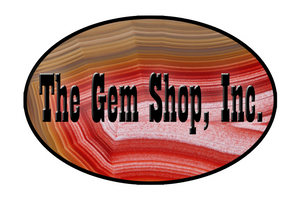Ocean Jasper History
Every year at the Tucson Gem & Mineral Show in Arizona, new rock and gem finds are brought to the market. The year of 2000 was no exception. Founder Eugene Mueller was in Tucson early, packing his truck to go to Quartzite when Paul Obeniche of Madagascar Minerals came by and said, "Gene, look at this new rock."
Mueller's friend, Owen LaHaie, was present to see the samples as well. On the way to Quartzite, Mueller could not get the image of those two sample rocks out of his mind. He recognized the pattern to be similar to those found in a number of silica-rich rhyolites. Other rocks of this type have been in the market before, most notably Rainforest Jasper from Australia, Leopardskin Jasper from Mexico, and the famous Poppy Jasper from California. However, Mueller's brief encounter with this rock led him to believe that it far surpassed the quality of all other silica-rich rhyolites.
New discoveries brought to the market are usually new deposits of an already known material. It is rare indeed that a truly new material is found. Ocean Jasper was truly a new discovery and a material unique to any other type of rock on the market to date.
The Name: Ocean Jasper
Paul Obeniche and Eugene Mueller discussed at length concerning the name for this rock. Mueller came up with about 10 different names before they chose "Ocean Jasper." The material is categorized as an orbicular jasper. The term orbicular refers to the spherical forms found in many rhyolites. Many rhyolites have been sold or marketed as jasper, so there is a precedent for these rhyolitic patterns being associated with the word "jasper." To the best of Mueller's knowledge, there has never been a rock referred to as an "orbicular agate."
Ocean Jasper is an agate by the standard definition of the word ("agate" being translucent and "jasper" being opaque) because Ocean Jasper is rarely opaque. Mueller and Obeniche decided to call the material jasper due to the association between jasper and rhyolitic patterns, as well as the fact the "jasper" is listed as the mineral resource in the mining claims owned by Paul Obeniche.
The second half of the name arose from the location of the claims: by the edge of the ocean. The deposit was found along the northwest coast of Madagascar. The forms in the rock itself are also suggestive of the bubbling surf of the sea.
The Gem Shop, Inc. was originally named the exclusive U.S. distributor for rough Ocean Jasper and upon its introduction, an ad was published in the May issue of the Lapidary Journal which can be found in the Annual Buyer's Directory:
"This new rock has been found along the northwest coast of Madagascar after years of unsuccessful searching. The deposit formed as a rhyolite flow but has been completely silicified. The rhyolitic eyes or orbs come in an astonishing array of colors and color combinations. The background can be white, pink, green, red, or yellow. Botryoidal formations as well as white and deep green druzy are also common.
Small pieces of this jasper have been brought to market over the years but no one could identify the source until Paul Obeniche organized a systematic search of the northwest coast of Madagascar. The deposit has been discovered at the edge of the ocean. It can only be seen and collected at low tide. The area has no road so the material must be transported to civilization by boat. This wonderful new lapidary material is available from The Gem Shop, Inc. through Madagascar Minerals [Sogema-Madagascar Minerals]." - Lapidary Journal, Volume 54 Number 2, May 2000, Page 33
In 2006 the last rock from the original first vein was mined. The deposit was followed from the beach into the side of a hill for about 40 meters. As the deposit was followed it became a large tube-like formation, extending straight into the host rock. The jasper deposit became thinner as work progressed.
There have been eight different veins of Ocean Jasper mined since it was first discovered. Enter the Earth, a former tenant at the Tucson Showplace, has done most of the mining of these veins and was the main American distributor after The Gem Shop. The eighth vein in particular, brought to the market in 2022, was an exciting import considering that no new major deposits of Ocean Jasper were discovered in the previous 15 years. There are not many pieces of Eighth Vein Ocean Jasper on the market anymore, but some large specimens can still be found on Enter the Earth's website, and specimens from previous veins are still sold in our store.
